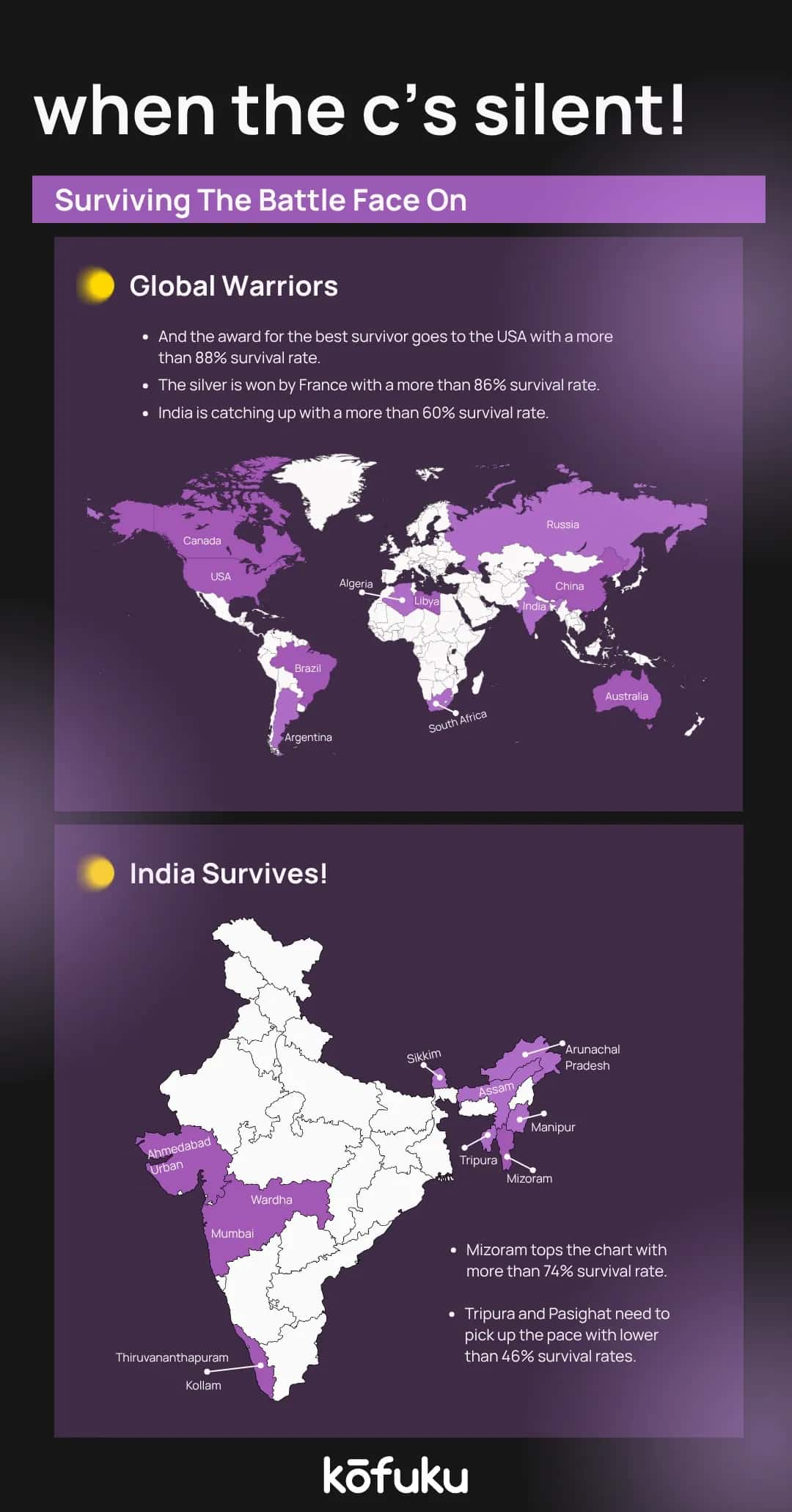Decoding Hope: Understanding the Breast Cancer Survival Rate


Introduction
Getting a diagnosis for breast cancer can bring someone’s world crashing down. It can be overwhelming and make people feel like they’ve run out of options, but not all hope is lost.
What is the breast cancer survival rate? This is one of the most frequently asked questions after a diagnosis. Survival rates are now increasing due to ongoing medical advancements, giving patients and their families hope and comfort.
This blog will aim to educate you more about the survival rates of breast cancer, how different stages impact the survival rates, and the knowledge you need to know to battle this illness.
Beyond the Numbers: What Does "Breast Cancer Survival Rate" Really Mean?
The percentage of patients who survive for a particular time following their diagnosis, usually five or ten years, is referred to as the breast cancer survival rate.
Keep in mind that these are general statistics based on studies conducted by researchers rather than something that is set in stone. Results are influenced by many variables, including patient age, tumour type, cancer stage, and treatment.
Different kinds of survival rates exist, including:
-
Overall survival rate: This measures how many patients are alive after a specific time.
-
Relative survival rate: Compares the survival of breast cancer patients with the general population.
These rates help people and their families make informed decisions and foster realistic expectations without shattering any of their hopes.
The Staging Game: How Stage Impacts Breast Cancer Survival Rate
Understanding The TNM System
The TNM system, tumour size (T), lymph node involvement (N), and metastasis (M), is used in breast cancer staging to determine the extent of cancer metastasis. Stages are assigned according to the extent of the cancer metastasis, and subsequently, the doctors decide the course of treatment and prognosis.
Survival Rate for Stage 1 Breast Cancer
Stage 0-1 is relatively not very concerning, as only A small, localised tumour is detected by this time. The five-year relative survival rate is higher than 98 per cent. The 20-year survival rate for stage 1 breast cancer is likewise very good, particularly when treatment is received early, proving the life-saving potential of early detection.
Survival Rate for Stage 2 Breast Cancer
Stage 2 denotes a larger tumour or lymph node spread. About 90% of people survive for five years. By age, younger patients frequently respond well to treatment, but they may experience more aggressive cancers. Elderly patients might face more health challenges, which can greatly influence outcomes.
Survival Rate for Stage 3 Breast Cancer
Larger tumours, widespread lymph node involvement, or local tissue spread are characteristics of stage 3.
Although survival rates for this stage are low compared to the first two, they are still encouraging with the numbers at 72% after five years. While age plays a role, tumour biology, including hormone receptor status, frequently has a greater effect than age alone.
Survival Rate for Stage 4 Breast Cancer
When breast cancer reaches stage 4, it spreads to other organs. Although it is getting better, the five-year survival rate is only about 30%. Even with this metastatic disease, new treatments like immunotherapy and targeted medications are enabling many people to live longer, more satisfying lives, despite the lower survival rate.

Beyond Stage: Understanding Other Factors Influencing Breast Cancer Survival Rate
Triple Negative Breast Cancer Survival Rate by Tumour Biology and Subtype
Triple-negative breast cancer (TNBC) lacks HER2 proteins and hormone receptors, thus making it much more aggressive and more difficult to treat. Although localised TNBC has a lower five-year survival rate than other subtypes (roughly 77%), treatments like immunotherapy show a lot of promise.
Hormone Receptor-positive (ER+/PR+) and HER2-positive
Targeted treatments are effective in treating HER2-positive cancers. Hormone treatments for tumours that express hormone receptors frequently have good long-term results.
Age at Diagnosis
Younger patients can tolerate aggressive treatment better, but they may develop cancers that grow more quickly. Older people may have other health issues that can make treatment complicated. Across age groups, this complexity affects stage 2, stage 3, and stage 4 survival rates.
Treatment Effectiveness
Improvements in targeted therapy, immunotherapy, radiation, chemotherapy, and surgery continue to greatly increase survival rates compared to how it was in the olden days.
Lifestyle and General Health
Recovery and treatment tolerance may be impacted by a patient's general health and lifestyle choices, including food, exercise, alcohol, and smoking.
Reaction to Therapy
Decisions regarding future treatment and prognosis are frequently influenced by how quickly a tumour responds to therapy.
Recurrence
Long-term survival can be impacted by the risk of cancer recurrence, which depends on individuals and varies by subtype and stage. Continued follow-up care in this scenario is extremely important.
Navigating Your Journey: Resources and Support for Breast Cancer Patients
1. Early Detection:
The odds of survival are significantly increased when cancer is detected early. it is most treatable at this point.
2. Tailored Treatment Programs:
Breast cancers are not all the same. Tumour characteristics, stage, patient health, and preferences all influence the treatment plan. Always discuss the prognosis with your medical team.
3. Multidisciplinary Group:
A well-coordinated team, including surgeons, medical oncologists, radiation specialists, pathologists, and nurses, is imperative for successful treatment.
4. Support Systems:
Emotional and mental support is equally important as physical care. Financial aid programs, patient navigators, counsellors, and support groups are all crucial for a patient's journey.
5. Hope and Advancement:
Science keeps raising survival rates through clinical trials and next-generation treatments, providing hope to millions of people out there.

Conclusion: A Future of Hope and Progress in Breast Cancer Survival
Receiving a breast cancer diagnosis can change your life, but it does not dictate your future. Early detection, cutting-edge treatments, and individualised care are helping raise survival rates.
Although prognosis is influenced by tumour type, age, and staging, each patient's experience and body is different. There is a person out there with courage, strength, and hope fighting against this illness, and we owe them to educate other people and help them overcome their struggles.
More people are thriving thanks to continued research, treatments, and robust support networks. In the end, you need to rely on your care team, have faith in the progress, and continue to take charge of your health.
There is genuine hope ahead, and you are not alone. And don’t forget to get regular screenings and consult your doctor if you suspect any symptoms.

FAQs
Q. Can stage 3 breast cancer be cured?
A. Though stage 3 cancer is advanced, it can be cured based on factors like the size of the tumour, hormone receptor status, etc. Women with stage 3 breast cancer can survive longer by getting treatment on time.
Q. What is the life expectancy of a breast cancer patient?
A. Life expectancy of a breast cancer patient relies on factors like tumour attributes, cancer stage, and the body’s reaction to treatment. Usually, the five-year survival rate for breast cancer patients is 90%, for stage 4 patients it is 28%, and for early-stage patients it is 99%.
Q. What is the deadliest stage of breast cancer?
A. Typically, stage 4 is regarded as the deadliest stage of breast cancer because at that point it reaches other body organs like bones, lungs, etc. During this stage, treatment involves handling symptoms, reducing the progression of the disease, etc.
Q. How curable is stage 4 breast cancer?
A. Well, stage 4 cancer can’t be cured because cancer spreads to other parts of the body. Though with innovative treatment alternatives, like immunotherapies, women at this stage of breast cancer can show signs of improvement in health and survival.
Q. Can breast cancer be fully cured?
A. Yes, breast cancer is entirely curable if it is diagnosed and treated at the initial stages. Moreover, the 5-year survival rate for females detected with breast cancer stage 1 is generally around 100%.
Q. Is stage 3 treatable?
A. Yes, stage 3 cancer can be treated with the help of chemotherapy, surgery, radiation therapy, and hormone therapy. The objectives include getting rid of cancer, preventing it from recurring, and increasing the survival rate.
Q. What is the 20-year survival rate for stage 3 breast cancer?
A. The 20-year survival rate for stage 3 cancer is wholly subject to the nature of the tumour and how the body reacts to treatment. According to the research, almost 50 to 60% of women diagnosed with stage 3 breast cancer can easily live for 20 years or more after the timely diagnosis and treatment.

Aruna Irani's Regret: Her Cancer Returned After Skipping Chemo. Here's What Every Woman Must Know About Breast Cancer Stages

Hina Khan (Yeh Rishta Kya Kehlata Hain) Is Fighting Stage 3 Breast Cancer: A Guide to Treatment and Understanding Advanced Stages

Is Your Bra Linked to Breast Cancer?

Is There a Breast Cancer Vaccine? Yes, Here’s All You Need to Know About It

The Detailed Guide To Male Breast Cancer

